Introduction
1. Data sources
2. Analysis
Selected Findings
1. Incidence
Table 1.
| Site/Type |
New cases |
Deaths |
Prevalent casesa) |
||||||
|---|---|---|---|---|---|---|---|---|---|
| Both | Male | Female | Both | Male | Female | Both | Male | Female | |
| All sites | 224,177 | 112,385 | 111,792 | 73,759 | 46,462 | 27,297 | 1,234,879 | 547,837 | 687,042 |
| Lip, oral cavity, and pharynx | 2,913 | 2,135 | 778 | 1,036 | 809 | 227 | 17,024 | 11,501 | 5,523 |
| Esophagus | 2,332 | 2,116 | 216 | 1,398 | 1,278 | 120 | 7,444 | 6,714 | 730 |
| Stomach | 30,847 | 20,839 | 10,008 | 9,342 | 6,090 | 3,252 | 207,145 | 137,655 | 69,490 |
| Colon and rectum | 28,988 | 17,445 | 11,543 | 8,135 | 4,666 | 3,469 | 173,459 | 103,488 | 69,971 |
| Liver | 16,254 | 12,152 | 4,102 | 11,335 | 8,494 | 2,841 | 51,402 | 38,434 | 12,968 |
| Gallbladderb) | 5,131 | 2,600 | 2,531 | 3,688 | 1,818 | 1,870 | 14,778 | 7,532 | 7,246 |
| Pancreas | 5,403 | 2,940 | 2,463 | 4,778 | 2,616 | 2,162 | 7,032 | 3,803 | 3,229 |
| Larynx | 1,099 | 1,036 | 63 | 412 | 389 | 23 | 8,600 | 8,076 | 524 |
| Lung | 22,118 | 15,367 | 6,751 | 16,654 | 12,175 | 4,479 | 53,480 | 34,422 | 19,058 |
| Breast | 16,589 | 68 | 16,521 | 2,013 | 20 | 1,993 | 132,139 | 558 | 131,581 |
| Cervix uteri | 3,584 | - | 3,584 | 889 | - | 889 | 43,523 | - | 43,523 |
| Corpus uteri | 1,979 | - | 1,979 | 244 | - | 244 | 15,191 | - | 15,191 |
| Ovary | 2,167 | - | 2,167 | 910 | - | 910 | 14,171 | - | 14,171 |
| Prostate | 9,258 | 9,258 | - | 1,460 | 1,460 | - | 49,007 | 49,007 | - |
| Testis | 243 | 243 | - | 13 | 13 | - | 2,210 | 2,210 | - |
| Kidney | 4,152 | 2,882 | 1,270 | 917 | 663 | 254 | 26,015 | 17,551 | 8,464 |
| Bladder | 3,485 | 2,798 | 687 | 1,221 | 918 | 303 | 25,497 | 20,754 | 4,743 |
| Brain and CNS | 1,703 | 933 | 770 | 1,186 | 619 | 567 | 8,626 | 4,508 | 4,118 |
| Thyroid | 44,007 | 8,052 | 35,955 | 373 | 127 | 246 | 258,795 | 40,921 | 217,874 |
| Hodgkin lymphoma | 264 | 177 | 87 | 64 | 44 | 20 | 2,006 | 1,281 | 725 |
| Non-Hodgkin lymphoma | 4,553 | 2,542 | 2,011 | 1,523 | 920 | 603 | 26,426 | 14,299 | 12,127 |
| Multiple myeloma | 1,272 | 696 | 576 | 823 | 472 | 351 | 3,842 | 2,042 | 1,800 |
| Leukemia | 2,826 | 1,595 | 1,231 | 1,666 | 919 | 747 | 14,890 | 8,216 | 6,674 |
| Other and ill-defined | 13,010 | 6,511 | 6,499 | 3,679 | 1,952 | 1,727 | 72,177 | 34,865 | 37,312 |
Table 2.
| Site/Type |
Crude incidence rate per 100,000 |
Age-standardized incidence rate per 100,000a) |
||||
|---|---|---|---|---|---|---|
| Both | Male | Female | Both | Male | Female | |
| All sites | 445.3 | 446.2 | 444.4 | 299.0 | 326.4 | 290.1 |
| Lip, oral cavity, and pharynx | 5.8 | 8.5 | 3.1 | 3.9 | 6.1 | 2.0 |
| Esophagus | 4.6 | 8.4 | 0.9 | 3.0 | 6.1 | 0.5 |
| Stomach | 61.3 | 82.7 | 39.8 | 39.9 | 59.3 | 23.5 |
| Colon and rectum | 57.6 | 69.3 | 45.9 | 37.3 | 50.0 | 26.8 |
| Liver | 32.3 | 48.2 | 16.3 | 21.1 | 34.3 | 9.5 |
| Gallbladderb) | 10.2 | 10.3 | 10.1 | 6.3 | 7.6 | 5.3 |
| Pancreas | 10.7 | 11.7 | 9.8 | 6.7 | 8.4 | 5.4 |
| Larynx | 2.2 | 4.1 | 0.3 | 1.4 | 3.0 | 0.1 |
| Lung | 43.9 | 61.0 | 26.8 | 27.4 | 44.3 | 14.9 |
| Breast | 33.0 | 0.3 | 65.7 | 22.6 | 0.2 | 44.7 |
| Cervix uteri | 7.1 | - | 14.2 | 4.9 | - | 9.5 |
| Corpus uteri | 3.9 | - | 7.9 | 2.7 | - | 5.3 |
| Ovary | 4.3 | - | 8.6 | 3.1 | - | 6.0 |
| Prostate | 18.4 | 36.8 | - | 11.6 | 27.0 | - |
| Testis | 0.5 | 1.0 | - | 0.5 | 0.9 | - |
| Kidney | 8.2 | 11.4 | 5.0 | 5.6 | 8.2 | 3.2 |
| Bladder | 6.9 | 11.1 | 2.7 | 4.3 | 8.1 | 1.4 |
| Brain and CNS | 3.4 | 3.7 | 3.1 | 2.8 | 3.3 | 2.4 |
| Thyroid | 87.4 | 32.0 | 142.9 | 62.5 | 23.0 | 102.4 |
| Hodgkin lymphoma | 0.5 | 0.7 | 0.3 | 0.5 | 0.6 | 0.3 |
| Non-Hodgkin lymphoma | 9.0 | 10.1 | 8.0 | 6.6 | 7.9 | 5.6 |
| Multiple myeloma | 2.5 | 2.8 | 2.3 | 1.6 | 2.0 | 1.4 |
| Leukemia | 5.6 | 6.3 | 4.9 | 4.9 | 5.9 | 4.1 |
| Other and ill-defined | 25.8 | 25.9 | 25.8 | 17.6 | 20.1 | 15.7 |
2. Mortality
Table 3.
| Rank | Cause of death | No. of deaths | Percentage of all deaths | Age-standardized death rate per 100,000a) |
|---|---|---|---|---|
| All causes | 267,221 | 100.0 | 326.6 | |
| 1 | Cancer | 73,759 | 27.6 | 90.2 |
| 2 | Heart disease | 26,442 | 9.9 | 30.7 |
| 3 | Cerebrovascular disease | 25,744 | 9.6 | 29.0 |
| 4 | Intentional self-harm (suicide) | 14,160 | 5.3 | 20.4 |
| 5 | Diabetes mellitus | 11,557 | 4.3 | 13.2 |
| 6 | Pneumonia | 10,314 | 3.9 | 11.4 |
| 7 | Chronic lower respiratory diseases | 7,831 | 2.9 | 8.5 |
| 8 | Disease of liver | 6,793 | 2.5 | 8.8 |
| 9 | Transport accidents | 6,502 | 2.4 | 9.6 |
| 10 | Hypertensive diseases | 5,239 | 2.0 | 5.8 |
| Others | 78,880 | 29.6 | 99.2 |
Source: Mortality Data, 2012, Statistics Korea [1].
Table 4.
| Site/Type |
Crude mortality rate per 100,000 |
Age-standardized mortality rate per 100,000a) |
||||
|---|---|---|---|---|---|---|
| Both | Male | Female | Both | Male | Female | |
| All sites | 146.5 | 184.5 | 108.5 | 90.2 | 135.2 | 57.7 |
| Lip, oral cavity, and pharynx | 2.1 | 3.2 | 0.9 | 1.3 | 2.3 | 0.5 |
| Esophagus | 2.8 | 5.1 | 0.5 | 1.7 | 3.7 | 0.2 |
| Stomach | 18.6 | 24.2 | 12.9 | 11.2 | 17.6 | 6.5 |
| Colon and rectum | 16.2 | 18.5 | 13.8 | 9.7 | 13.7 | 6.8 |
| Liver | 22.5 | 33.7 | 11.3 | 14.4 | 24.1 | 6.1 |
| Gallbladderb) | 7.3 | 7.2 | 7.4 | 4.3 | 5.3 | 3.6 |
| Pancreas | 9.5 | 10.4 | 8.6 | 5.8 | 7.6 | 4.4 |
| Larynx | 0.8 | 1.5 | 0.1 | 0.5 | 1.1 | 0.0 |
| Lung | 33.1 | 48.3 | 17.8 | 19.8 | 35.1 | 8.9 |
| Breast | 4.0 | 0.1 | 7.9 | 2.6 | 0.1 | 5.1 |
| Cervix uteri | 1.8 | - | 3.5 | 1.1 | - | 2.0 |
| Corpus uteri | 0.5 | - | 1.0 | 0.3 | - | 0.6 |
| Ovary | 1.8 | - | 3.6 | 1.2 | - | 2.2 |
| Prostate | 2.9 | 5.8 | - | 1.6 | 4.5 | - |
| Testis | 0.0 | 0.1 | - | 0.0 | 0.0 | - |
| Kidney | 1.8 | 2.6 | 1.0 | 1.1 | 1.9 | 0.5 |
| Bladder | 2.4 | 3.6 | 1.2 | 1.3 | 2.8 | 0.5 |
| Brain and CNS | 2.4 | 2.5 | 2.3 | 1.8 | 2.0 | 1.6 |
| Thyroid | 0.7 | 0.5 | 1.0 | 0.4 | 0.4 | 0.5 |
| Hodgkin lymphoma | 0.1 | 0.2 | 0.1 | 0.1 | 0.1 | 0.1 |
| Non-Hodgkin lymphoma | 3.0 | 3.7 | 2.4 | 1.9 | 2.7 | 1.3 |
| Multiple myeloma | 1.6 | 1.9 | 1.4 | 1.0 | 1.4 | 0.8 |
| Leukemia | 3.3 | 3.6 | 3.0 | 2.4 | 3.0 | 2.0 |
| Other and ill-defined | 7.3 | 7.7 | 6.9 | 4.6 | 5.9 | 3.7 |
3. Trends in cancer incidence
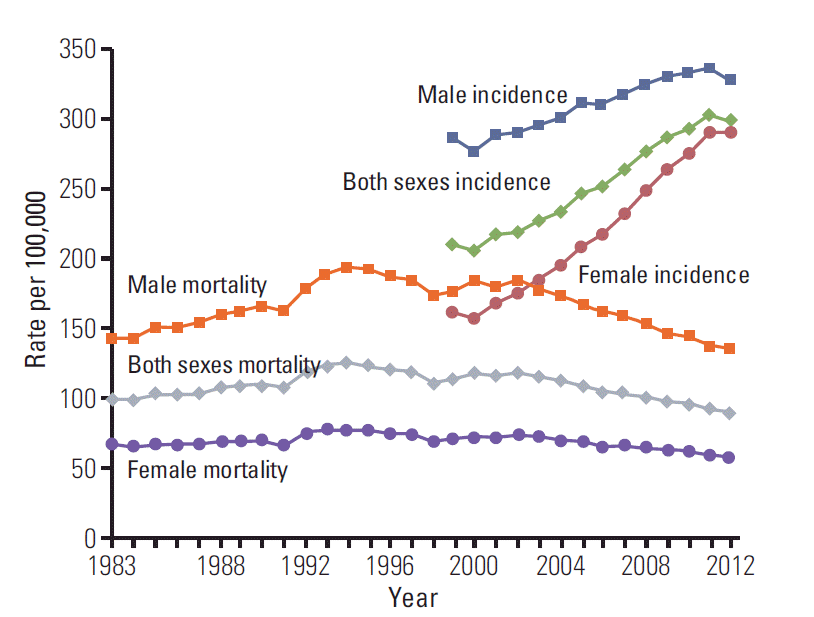 | Fig. 1.Annual age-standardized cancer incidence and death rates by sex for all sites from 1983 to 2012 in Korea. Age standardization was based on the world standard population. |
Table 5.
| Site/Type |
Year |
||||||||||||||
|---|---|---|---|---|---|---|---|---|---|---|---|---|---|---|---|
| 1999 | 2000 | 2001 | 2002 | 2003 | 2004 | 2005 | 2006 | 2007 | 2008 | 2009 | 2010 | 2011 | 2012 | APC | |
| All sites | 210.5 | 205.1 | 216.7 | 220.1 | 227.8 | 235.0 | 247.9 | 252.1 | 263.4 | 275.8 | 286.6 | 292.9 | 302.8 | 299.0 | 3.3a) |
| Lip, oral cavity, and pharynx | 3.6 | 4.4 | 3.6 | 3.7 | 3.8 | 3.8 | 3.8 | 3.8 | 3.9 | 4.0 | 3.8 | 4.0 | 4.0 | 3.9 | 0.4 |
| Esophagus | 4.1 | 3.7 | 3.9 | 3.8 | 3.6 | 3.6 | 3.5 | 3.4 | 3.3 | 3.3 | 3.1 | 3.1 | 3.0 | 3.0 | -2.2a) |
| Stomach | 43.6 | 42.3 | 44.0 | 43.6 | 43.3 | 41.2 | 44.4 | 42.9 | 41.8 | 42.6 | 43.4 | 42.5 | 42.7 | 39.9 | -0.3 |
| Colon and rectum | 20.4 | 21.0 | 22.9 | 24.7 | 26.9 | 28.6 | 31.0 | 32.5 | 33.8 | 34.9 | 36.9 | 36.9 | 38.1 | 37.3 | 5.3a) |
| Liver | 27.9 | 26.7 | 27.3 | 26.5 | 25.8 | 25.6 | 25.8 | 24.6 | 24.4 | 24.1 | 23.5 | 22.8 | 22.4 | 21.1 | -1.9a) |
| Gallbladderb) | 6.5 | 6.4 | 6.7 | 6.7 | 6.7 | 6.9 | 7.1 | 6.6 | 6.6 | 6.4 | 6.8 | 6.6 | 6.4 | 6.3 | -0.2 |
| Pancreas | 5.6 | 5.5 | 5.5 | 5.8 | 5.9 | 6.0 | 6.3 | 6.2 | 6.3 | 6.4 | 6.3 | 6.4 | 6.7 | 6.7 | 1.5a) |
| Larynx | 2.3 | 2.2 | 2.4 | 2.2 | 2.1 | 1.9 | 2.0 | 1.8 | 1.8 | 1.7 | 1.7 | 1.6 | 1.5 | 1.4 | -3.7a) |
| Lung | 28.5 | 27.7 | 28.3 | 28.5 | 27.9 | 28.8 | 29.0 | 28.7 | 28.4 | 28.2 | 28.3 | 28.6 | 28.6 | 27.4 | 0.0 |
| Breast | 10.7 | 10.8 | 12.7 | 13.9 | 14.2 | 15.0 | 16.3 | 16.9 | 18.1 | 18.9 | 19.6 | 20.6 | 22.3 | 22.6 | 6.0a) |
| Cervix uteri | 8.5 | 7.9 | 8.3 | 7.7 | 7.4 | 6.9 | 6.5 | 6.4 | 5.7 | 5.9 | 5.5 | 5.6 | 5.2 | 4.9 | -4.2a) |
| Corpus uteri | 1.4 | 1.3 | 1.5 | 1.7 | 1.9 | 1.9 | 2.0 | 2.1 | 2.2 | 2.4 | 2.6 | 2.6 | 2.7 | 2.7 | 5.6a) |
| Ovary | 2.7 | 2.5 | 2.5 | 2.6 | 2.7 | 2.7 | 2.8 | 2.8 | 3.1 | 2.9 | 2.8 | 3.0 | 2.9 | 3.1 | 1.4a) |
| Prostate | 3.1 | 2.7 | 3.6 | 3.9 | 4.8 | 6.0 | 6.3 | 7.3 | 8.6 | 9.8 | 10.6 | 11.0 | 11.9 | 11.6 | 13.0a) |
| Testis | 0.3 | 0.3 | 0.3 | 0.3 | 0.3 | 0.3 | 0.3 | 0.4 | 0.4 | 0.4 | 0.4 | 0.4 | 0.5 | 0.5 | 4.5a) |
| Kidney | 3.0 | 2.9 | 3.3 | 3.4 | 3.5 | 3.7 | 4.1 | 4.4 | 4.8 | 5.1 | 5.2 | 5.3 | 5.6 | 5.6 | 5.8a) |
| Bladder | 4.6 | 4.6 | 4.9 | 4.7 | 5.1 | 5.1 | 5.1 | 4.9 | 5.0 | 4.8 | 4.6 | 4.7 | 4.6 | 4.3 | -0.4 |
| Brain and CNS | 2.9 | 2.8 | 2.8 | 2.6 | 2.9 | 2.9 | 3.0 | 2.9 | 3.1 | 3.0 | 3.0 | 3.1 | 2.7 | 2.8 | 0.4 |
| Thyroid | 6.3 | 6.1 | 7.9 | 9.5 | 12.8 | 17.2 | 20.7 | 25.4 | 32.8 | 41.4 | 48.1 | 53.6 | 59.1 | 62.5 | 22.3a) |
| Hodgkin lymphoma | 0.2 | 0.3 | 0.3 | 0.3 | 0.3 | 0.4 | 0.3 | 0.3 | 0.4 | 0.4 | 0.4 | 0.4 | 0.5 | 0.5 | 5.0a) |
| Non-Hodgkin lymphoma | 4.5 | 4.2 | 4.5 | 4.6 | 4.9 | 5.3 | 5.3 | 5.5 | 5.6 | 5.7 | 6.2 | 6.2 | 6.5 | 6.6 | 3.6a) |
| Multiple myeloma | 1.0 | 1.0 | 1.1 | 1.1 | 1.1 | 1.2 | 1.3 | 1.3 | 1.4 | 1.4 | 1.5 | 1.5 | 1.4 | 1.6 | 3.7a) |
| Leukemia | 4.7 | 4.3 | 4.7 | 4.8 | 4.8 | 4.8 | 4.7 | 4.9 | 4.8 | 5.0 | 5.1 | 5.0 | 5.2 | 4.9 | 0.9a) |
| Other and ill-defined | 14.3 | 13.5 | 13.9 | 13.5 | 15.2 | 15.3 | 16.2 | 16.2 | 17.2 | 17.1 | 17.1 | 17.5 | 18.1 | 17.6 | 2.4a) |
Table 6.
| Site/Type |
Year |
||||||||||||||
|---|---|---|---|---|---|---|---|---|---|---|---|---|---|---|---|
| 1999 | 2000 | 2001 | 2002 | 2003 | 2004 | 2005 | 2006 | 2007 | 2008 | 2009 | 2010 | 2011 | 2012 | APC | |
| All sites | 285.0 | 276.7 | 288.3 | 290.0 | 295.1 | 299.6 | 311.5 | 310.3 | 316.9 | 323.9 | 330.6 | 331.3 | 336.1 | 326.4 | 1.5a) |
| Lip, oral cavity, and pharynx | 6.1 | 7.1 | 6.0 | 6.2 | 6.5 | 6.2 | 6.1 | 6.2 | 6.3 | 6.5 | 6.1 | 6.1 | 6.3 | 6.1 | -0.2 |
| Esophagus | 8.8 | 8.0 | 8.3 | 8.2 | 7.7 | 7.7 | 7.6 | 7.2 | 7.0 | 7.0 | 6.6 | 6.5 | 6.2 | 6.1 | -2.6a) |
| Stomach | 66.2 | 65.0 | 67.2 | 66.6 | 66.0 | 62.3 | 66.9 | 65.4 | 63.1 | 64.5 | 65.0 | 63.3 | 63.7 | 59.3 | -0.5a) |
| Colon and rectum | 26.2 | 27.2 | 29.6 | 32.9 | 35.3 | 38.0 | 41.2 | 43.3 | 45.3 | 47.0 | 49.9 | 50.0 | 51.9 | 50.0 | 5.7a) |
| Liver | 46.8 | 44.7 | 45.1 | 43.9 | 42.3 | 42.2 | 42.6 | 40.3 | 39.8 | 39.5 | 38.2 | 36.8 | 35.9 | 34.3 | -2.1a) |
| Gallbladderb) | 8.1 | 7.8 | 8.2 | 8.1 | 7.8 | 8.4 | 8.7 | 8.1 | 7.9 | 7.6 | 8.1 | 8.2 | 7.6 | 7.6 | -0.3 |
| Pancreas | 7.8 | 7.6 | 7.6 | 7.9 | 7.7 | 8.0 | 8.3 | 8.0 | 8.2 | 8.4 | 8.1 | 8.0 | 8.6 | 8.4 | 0.8a) |
| Larynx | 4.9 | 4.5 | 5.1 | 4.7 | 4.5 | 4.1 | 4.3 | 3.8 | 3.8 | 3.5 | 3.6 | 3.4 | 3.2 | 3.0 | -3.7a) |
| Lung | 51.4 | 49.8 | 51.1 | 51.0 | 50.0 | 50.8 | 50.9 | 49.2 | 48.7 | 47.6 | 47.5 | 47.5 | 46.4 | 44.3 | -0.9a) |
| Breast | 0.2 | 0.3 | 0.2 | 0.3 | 0.2 | 0.2 | 0.2 | 0.2 | 0.1 | 0.3 | 0.2 | 0.2 | 0.2 | 0.2 | -1.1 |
| Prostate | 8.4 | 7.2 | 9.5 | 10.1 | 12.5 | 15.1 | 15.8 | 18.0 | 20.9 | 23.5 | 25.2 | 26.0 | 27.7 | 27.0 | 11.6a) |
| Testis | 0.6 | 0.5 | 0.6 | 0.6 | 0.6 | 0.6 | 0.6 | 0.7 | 0.7 | 0.7 | 0.8 | 0.8 | 0.9 | 0.9 | 4.4a) |
| Kidney | 4.5 | 4.4 | 4.9 | 5.0 | 5.2 | 5.5 | 6.0 | 6.5 | 7.1 | 7.4 | 7.6 | 8.0 | 8.2 | 8.2 | 5.5a) |
| Bladder | 9.0 | 9.0 | 9.4 | 9.0 | 9.7 | 9.8 | 9.8 | 9.6 | 9.4 | 9.2 | 8.7 | 8.8 | 8.8 | 8.1 | -0.6 |
| Brain and CNS | 3.2 | 3.1 | 3.1 | 2.9 | 3.3 | 3.3 | 3.3 | 3.2 | 3.4 | 3.4 | 3.5 | 3.5 | 3.0 | 3.3 | 0.6 |
| Thyroid | 2.1 | 1.9 | 2.4 | 2.7 | 3.7 | 4.8 | 5.9 | 7.5 | 10.0 | 13.3 | 15.6 | 18.6 | 20.4 | 23.0 | 23.6a) |
| Hodgkin lymphoma | 0.4 | 0.4 | 0.4 | 0.3 | 0.4 | 0.5 | 0.4 | 0.4 | 0.5 | 0.5 | 0.5 | 0.6 | 0.6 | 0.6 | 4.1a) |
| Non-Hodgkin lymphoma | 5.8 | 5.5 | 5.8 | 5.8 | 6.2 | 6.7 | 6.5 | 6.9 | 7.0 | 6.8 | 7.5 | 7.4 | 7.7 | 7.9 | 2.7a) |
| Multiple myeloma | 1.2 | 1.3 | 1.4 | 1.4 | 1.4 | 1.4 | 1.6 | 1.5 | 1.6 | 1.7 | 1.9 | 1.8 | 1.8 | 2.0 | 3.5a) |
| Leukemia | 5.5 | 5.0 | 5.4 | 5.8 | 5.5 | 5.7 | 5.6 | 5.6 | 5.7 | 5.8 | 6.0 | 6.0 | 6.1 | 5.9 | 1.0a) |
| Other and ill-defined | 17.9 | 16.5 | 16.8 | 16.5 | 18.5 | 18.3 | 19.3 | 18.9 | 20.3 | 19.8 | 20.0 | 19.8 | 20.8 | 20.1 | 1.7a) |
Table 7.
| Site/Type |
Year |
||||||||||||||
|---|---|---|---|---|---|---|---|---|---|---|---|---|---|---|---|
| 1999 | 2000 | 2001 | 2002 | 2003 | 2004 | 2005 | 2006 | 2007 | 2008 | 2009 | 2010 | 2011 | 2012 | APCa) | |
| All sites | 161.1 | 157.4 | 169.0 | 174.6 | 184.5 | 193.6 | 208.0 | 216.6 | 232.3 | 249.6 | 263.6 | 274.8 | 289.3 | 290.1 | 5.3a) |
| Lip, oral cavity, and pharynx | 1.6 | 2.4 | 1.7 | 1.7 | 1.7 | 1.9 | 1.9 | 1.8 | 1.9 | 1.9 | 1.8 | 2.2 | 2.1 | 2.0 | 1.1 |
| Esophagus | 0.6 | 0.6 | 0.6 | 0.5 | 0.6 | 0.5 | 0.4 | 0.5 | 0.5 | 0.5 | 0.4 | 0.4 | 0.4 | 0.5 | -2.2a) |
| Stomach | 26.7 | 25.2 | 26.2 | 26.3 | 25.9 | 24.7 | 26.8 | 25.1 | 24.8 | 25.1 | 25.7 | 25.3 | 25.3 | 23.5 | -0.5 |
| Colon and rectum | 16.4 | 16.4 | 17.9 | 18.8 | 20.5 | 21.5 | 23.0 | 24.1 | 24.6 | 25.2 | 26.3 | 26.1 | 26.7 | 26.8 | 4.3a) |
| Liver | 12.3 | 11.8 | 12.2 | 11.8 | 11.5 | 11.3 | 11.4 | 11.1 | 11.1 | 10.7 | 10.6 | 10.4 | 10.4 | 9.5 | -1.6a) |
| Gallbladderb) | 5.3 | 5.5 | 5.7 | 5.8 | 5.8 | 5.9 | 6.0 | 5.5 | 5.6 | 5.5 | 5.8 | 5.4 | 5.5 | 5.3 | -0.2 |
| Pancreas | 4.0 | 4.0 | 4.0 | 4.2 | 4.5 | 4.5 | 4.7 | 4.7 | 4.8 | 4.9 | 4.9 | 5.0 | 5.1 | 5.4 | 2.3a) |
| Larynx | 0.4 | 0.3 | 0.3 | 0.3 | 0.3 | 0.3 | 0.3 | 0.2 | 0.2 | 0.2 | 0.2 | 0.2 | 0.2 | 0.1 | -7.5a) |
| Lung | 12.4 | 12.5 | 12.3 | 12.6 | 12.4 | 13.0 | 13.5 | 14.0 | 14.0 | 14.2 | 14.2 | 14.7 | 15.3 | 14.9 | 1.7a) |
| Breast | 20.9 | 20.9 | 24.7 | 27.2 | 27.9 | 29.4 | 32.0 | 33.3 | 35.7 | 37.2 | 38.8 | 40.7 | 44.0 | 44.7 | 6.1a) |
| Cervix uteri | 16.3 | 15.1 | 15.8 | 14.8 | 14.2 | 13.1 | 12.4 | 12.2 | 11.1 | 11.5 | 10.7 | 10.9 | 10.2 | 9.5 | -4.0a) |
| Corpus uteri | 2.8 | 2.6 | 3.0 | 3.3 | 3.8 | 3.7 | 3.9 | 4.0 | 4.2 | 4.7 | 5.1 | 5.1 | 5.3 | 5.3 | 5.8a) |
| Ovary | 5.0 | 4.8 | 4.8 | 5.0 | 5.1 | 5.2 | 5.4 | 5.4 | 5.9 | 5.6 | 5.4 | 5.9 | 5.8 | 6.0 | 1.7a) |
| Kidney | 1.7 | 1.8 | 1.9 | 2.0 | 2.1 | 2.2 | 2.5 | 2.7 | 2.8 | 3.0 | 3.2 | 3.0 | 3.4 | 3.2 | 5.7a) |
| Bladder | 1.6 | 1.6 | 1.7 | 1.7 | 1.8 | 1.7 | 1.7 | 1.6 | 1.7 | 1.6 | 1.6 | 1.5 | 1.5 | 1.4 | -1.0 |
| Brain and CNS | 2.6 | 2.5 | 2.5 | 2.4 | 2.6 | 2.6 | 2.8 | 2.7 | 2.9 | 2.7 | 2.6 | 2.7 | 2.4 | 2.4 | 0.1 |
| Thyroid | 10.4 | 10.1 | 13.2 | 16.2 | 21.8 | 29.6 | 35.4 | 43.3 | 55.7 | 69.5 | 80.7 | 88.8 | 98.0 | 102.4 | 22.1a) |
| Hodgkin lymphoma | 0.1 | 0.2 | 0.2 | 0.2 | 0.2 | 0.2 | 0.2 | 0.3 | 0.3 | 0.3 | 0.3 | 0.3 | 0.4 | 0.3 | 6.0a) |
| Non-Hodgkin lymphoma | 3.4 | 3.2 | 3.4 | 3.5 | 4.0 | 4.1 | 4.4 | 4.4 | 4.4 | 4.8 | 5.1 | 5.2 | 5.6 | 5.6 | 4.5a) |
| Multiple myeloma | 0.8 | 0.8 | 0.9 | 0.8 | 1.0 | 1.0 | 1.2 | 1.1 | 1.2 | 1.2 | 1.2 | 1.3 | 1.1 | 1.4 | 4.1a) |
| Leukemia | 3.9 | 3.8 | 4.1 | 4.0 | 4.1 | 4.1 | 4.0 | 4.4 | 4.2 | 4.3 | 4.2 | 4.1 | 4.5 | 4.1 | 0.7a) |
| Other and ill-defined | 11.8 | 11.5 | 11.8 | 11.5 | 12.8 | 13.1 | 13.9 | 14.1 | 14.8 | 15.0 | 14.9 | 15.7 | 16.0 | 15.7 | 2.9a) |
4. Age-specific incidence rates
Table 8.
| Rank |
Age (yr) |
|||
|---|---|---|---|---|
| 0-14 | 15-34 | 35-64 | ≥65 | |
| Male | ||||
| 1 | Leukemia | Thyroid | Stomach | Lung |
| (-4.8) | (-15.4) | (-95.3) | (-441.3) | |
| 2 | Brain and CNS | Leukemia | Colon and rectum | Stomach |
| (-2.4) | (-3.1) | (-77.1) | (-412.5) | |
| 3 | Non-Hodgkin lymphoma | Colon and rectum | Liver | Colon and rectum |
| (-2.3) | (-3.1) | (-63.3) | (-354.9) | |
| 4 | Kidney | Non-Hodgkin lymphoma | Thyroid | Prostate |
| (-0.5) | (-2.8) | (-53.1) | (-293.7) | |
| 5 | Liver | Stomach | Lung | Liver |
| (-0.4) | (-2.4) | (-42.7) | (-202.8) | |
| Female | ||||
| 1 | Leukemia | Thyroid | Thyroid | Colon and rectum |
| (-3.4) | (-69.6) | (-246.2) | (-184.1) | |
| 2 | Non-Hodgkin lymphoma | Breast | Breast | Stomach |
| (-1.8) | (-10.8) | (-119.3) | (-155.4) | |
| 3 | Brain and CNS | Cervix uteri | Colon and rectum | Lung |
| (-1.7) | (-5.2) | (-45.3) | (-125.5) | |
| 4 | Ovarya) | Stomach | Stomach | Thyroid |
| (-0.9) | (-3.8) | (-39.7) | (-102.3) | |
| 5 | Thyroida) | Ovary | Lung | Liver |
| (-0.9) | (-3.0) | (-21.8) | (-71.8) | |
5. Trends in cancer mortality
6. Survival rates
Table 9.
| Site/Type |
Both |
Male |
Female |
||||||||||||
|---|---|---|---|---|---|---|---|---|---|---|---|---|---|---|---|
| 1993-1995 | 1996-2000 | 2001-2005 | 2008-2012 | Changea) | 1993-1995 | 1996-2000 | 2001-2005 | 2008-2012 | Changea) | 1993-1995 | 1996-2000 | 2001-2005 | 2008-2012 | Changea) | |
| All sites | 41.2 | 44.0 | 53.8 | 68.1 | 26.9 | 31.7 | 35.3 | 45.3 | 59.6 | 27.9 | 53.4 | 55.3 | 64.0 | 76.6 | 23.2 |
| Lip, oral cavity, and pharynx | 41.1 | 46.7 | 54.2 | 62.2 | 21.1 | 35.8 | 41.1 | 49.3 | 57.9 | 22.1 | 58.1 | 63.8 | 67.7 | 73.9 | 15.8 |
| Esophagus | 12.7 | 15.2 | 21.2 | 31.7 | 19.0 | 11.8 | 14.3 | 20.4 | 31.2 | 19.4 | 23.7 | 24.2 | 29.5 | 37.4 | 13.7 |
| Stomach | 42.8 | 46.6 | 57.7 | 71.5 | 28.7 | 43.0 | 46.9 | 58.4 | 72.2 | 29.2 | 42.6 | 46.0 | 56.4 | 70.0 | 27.4 |
| Colon and rectum | 54.8 | 58.0 | 66.6 | 74.8 | 20.0 | 55.3 | 59.0 | 68.5 | 76.9 | 21.6 | 54.2 | 56.8 | 64.1 | 71.8 | 17.6 |
| Liver | 10.7 | 13.2 | 20.2 | 30.1 | 19.4 | 9.9 | 12.9 | 20.1 | 30.4 | 20.5 | 13.6 | 14.2 | 20.4 | 29.3 | 15.7 |
| Gallbladderb) | 17.3 | 19.7 | 22.8 | 28.3 | 11.0 | 16.6 | 20.3 | 23.4 | 29.5 | 12.9 | 18.0 | 19.1 | 22.3 | 27.2 | 9.2 |
| Pancreas | 9.4 | 7.6 | 8.1 | 8.8 | -0.6 | 8.8 | 7.3 | 8.1 | 8.5 | -0.3 | 10.1 | 8.1 | 8.1 | 9.3 | -0.8 |
| Larynx | 59.7 | 62.3 | 66.1 | 73.4 | 13.7 | 60.2 | 62.8 | 66.8 | 73.6 | 13.4 | 55.4 | 57.8 | 58.2 | 69.6 | 14.2 |
| Lung | 11.3 | 12.7 | 16.2 | 21.9 | 10.6 | 10.4 | 11.6 | 15.0 | 19.4 | 9.0 | 14.2 | 16.2 | 19.7 | 28.2 | 14.0 |
| Breast | 77.9 | 83.2 | 88.5 | 91.3 | 13.4 | 75.1 | 85.6 | 87.0 | 90.0 | 14.9 | 78.0 | 83.2 | 88.5 | 91.3 | 13.3 |
| Cervix uteri | 77.5 | 80.0 | 81.3 | 80.3 | 2.8 | - | - | - | - | - | 77.5 | 80.0 | 81.3 | 80.3 | 2.8 |
| Corpus uteri | 81.5 | 81.8 | 84.6 | 86.9 | 5.4 | - | - | - | - | - | 81.5 | 81.8 | 84.6 | 86.9 | 5.4 |
| Ovary | 58.7 | 58.9 | 61.4 | 61.9 | 3.2 | - | - | - | - | - | 58.7 | 58.9 | 61.4 | 61.9 | 3.2 |
| Prostate | 55.9 | 67.2 | 80.2 | 92.3 | 36.4 | 55.9 | 67.2 | 80.2 | 92.3 | 36.4 | - | - | - | - | - |
| Testis | 85.4 | 90.4 | 90.6 | 94.2 | 8.8 | 85.4 | 90.4 | 90.6 | 94.2 | 8.8 | - | - | - | - | - |
| Kidney | 62.0 | 66.1 | 73.4 | 79.9 | 17.9 | 60.8 | 64.4 | 72.8 | 79.4 | 18.6 | 64.5 | 69.7 | 74.5 | 81.0 | 16.5 |
| Bladder | 69.1 | 73.1 | 75.5 | 75.4 | 6.3 | 70.0 | 74.8 | 77.3 | 77.6 | 7.6 | 65.5 | 66.3 | 68.5 | 66.5 | 1.0 |
| Brain and CNS | 38.5 | 39.0 | 40.7 | 42.2 | 3.7 | 37.2 | 37.5 | 40.1 | 40.5 | 3.3 | 40.2 | 40.7 | 41.4 | 44.3 | 4.1 |
| Thyroid | 94.2 | 94.9 | 98.3 | 100.1 | 5.9 | 87.2 | 89.5 | 95.8 | 100.4 | 13.2 | 95.4 | 95.9 | 98.7 | 100.0 | 4.6 |
| Hodgkin lymphoma | 68.0 | 71.2 | 76.6 | 82.6 | 14.6 | 67.6 | 68.1 | 74.6 | 82.1 | 14.5 | 68.6 | 77.4 | 80.6 | 83.5 | 14.9 |
| Non-Hodgkin lymphoma | 46.6 | 50.8 | 59.9 | 67.5 | 20.9 | 45.3 | 48.9 | 58.1 | 65.6 | 20.3 | 48.7 | 53.5 | 62.4 | 69.7 | 21.0 |
| Multiple myeloma | 22.1 | 19.8 | 29.3 | 36.4 | 14.3 | 21.1 | 17.8 | 29.6 | 35.8 | 14.7 | 23.3 | 22.1 | 28.9 | 37.1 | 13.8 |
| Leukemia | 26.5 | 33.3 | 41.8 | 48.9 | 22.4 | 26.2 | 32.3 | 41.6 | 48.8 | 22.6 | 26.8 | 34.6 | 42.0 | 49.2 | 22.4 |
| Other and ill-defined | 42.1 | 45.9 | 55.9 | 67.3 | 25.2 | 37.4 | 42.4 | 52.2 | 63.7 | 26.3 | 47.4 | 50.0 | 59.9 | 71.0 | 23.6 |
7. Prevalence rates
Table 10.
| Site/Type |
Crude prevalence rate per 100,000a) |
Age-standardized prevalence rate per 100,000b) |
||||
|---|---|---|---|---|---|---|
| Both | Male | Female | Both | Male | Female | |
| All sites | 2,452.8 | 2,175.0 | 2,730.9 | 1,649.2 | 1,592.2 | 1,788.0 |
| Lip, oral cavity, and pharynx | 33.8 | 45.7 | 22.0 | 23.0 | 33.2 | 14.3 |
| Esophagus | 14.8 | 26.7 | 2.9 | 9.5 | 19.3 | 1.6 |
| Stomach | 411.4 | 546.5 | 276.2 | 265.6 | 391.3 | 162.9 |
| Colon and rectum | 344.5 | 410.9 | 278.1 | 221.5 | 296.6 | 161.8 |
| Liver | 102.1 | 152.6 | 51.5 | 68.8 | 109.7 | 32.3 |
| GallbladderC) | 29.4 | 29.9 | 28.8 | 18.4 | 21.6 | 16.0 |
| Pancreas | 14.0 | 15.1 | 12.8 | 9.2 | 10.9 | 7.7 |
| Larynx | 17.1 | 32.1 | 2.1 | 11.0 | 23.4 | 1.2 |
| Lung | 106.2 | 136.7 | 75.8 | 68.3 | 99.1 | 44.8 |
| Breast | 262.5 | 2.2 | 523.0 | 176.5 | 1.6 | 346.7 |
| Cervix uteri | 86.4 | - | 173.0 | 57.5 | - | 111.7 |
| Corpus uteri | 30.2 | - | 60.4 | 20.6 | - | 40.4 |
| Ovary | 28.1 | - | 56.3 | 20.3 | - | 40.2 |
| Prostate | 97.3 | 194.6 | - | 58.4 | 141.6 | - |
| Testis | 4.4 | 8.8 | - | 4.0 | 7.8 | - |
| Kidney | 51.7 | 69.7 | 33.6 | 35.4 | 50.5 | 22.1 |
| Bladder | 50.6 | 82.4 | 18.9 | 31.3 | 59.9 | 9.9 |
| Brain and CNS | 17.1 | 17.9 | 16.4 | 15.0 | 16.0 | 13.9 |
| Thyroid | 514.0 | 162.5 | 866.0 | 358.7 | 114.8 | 600.7 |
| Hodgkin lymphoma | 4.0 | 5.1 | 2.9 | 3.4 | 4.3 | 2.5 |
| Non-Hodgkin lymphoma | 52.5 | 56.8 | 48.2 | 38.7 | 44.3 | 33.8 |
| Multiple myeloma | 7.6 | 8.1 | 7.2 | 5.0 | 5.8 | 4.4 |
| Leukemia | 29.6 | 32.6 | 26.5 | 28.4 | 31.8 | 25.1 |
| Other and ill-defined | 143.4 | 138.4 | 148.3 | 100.5 | 108.6 | 93.9 |
a) Crude prevalence rate: number of prevalent cases divided by the corresponding person-years of observation; Prevalent cases were defined as patients who were diagnosed between January 1, 1999 and December 31, 2012 and who were alive on January 1, 2013; Multiple primary cancer cases were counted multiple times,




 PDF
PDF Citation
Citation Print
Print


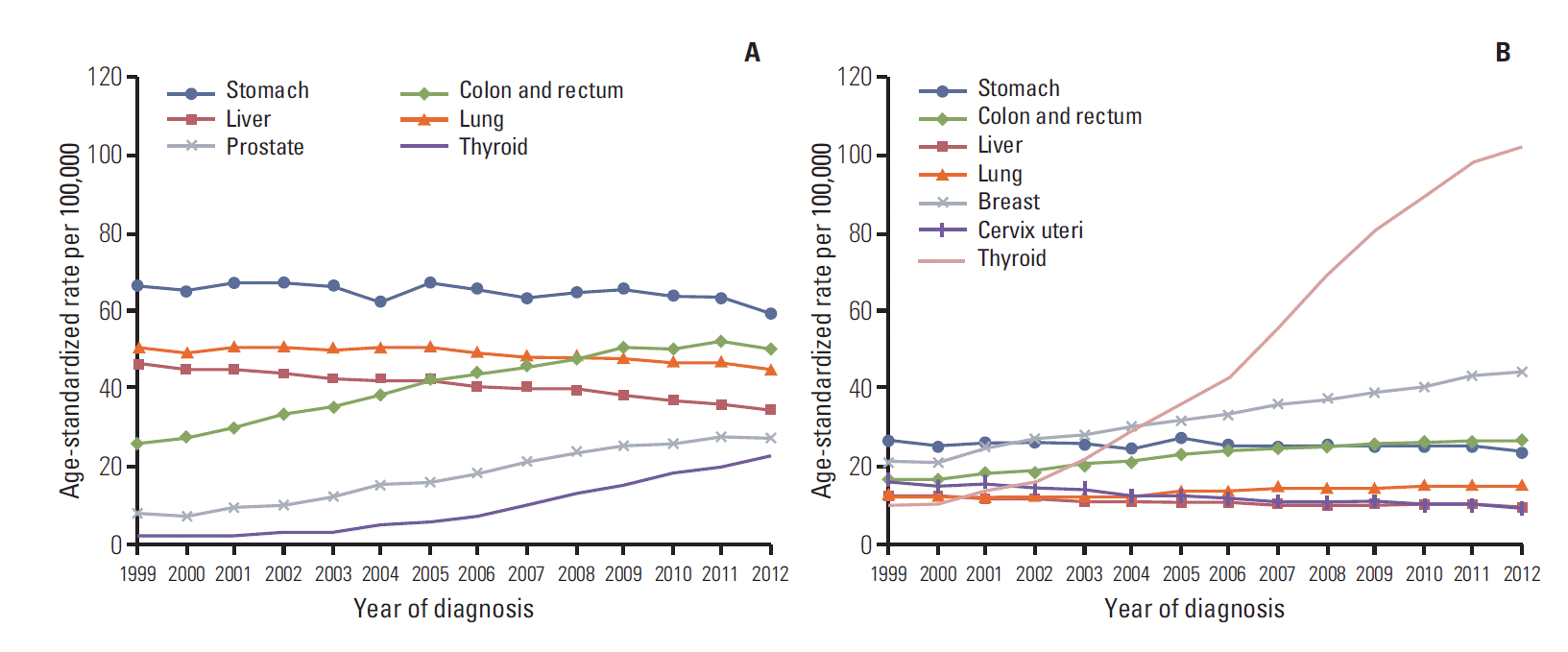
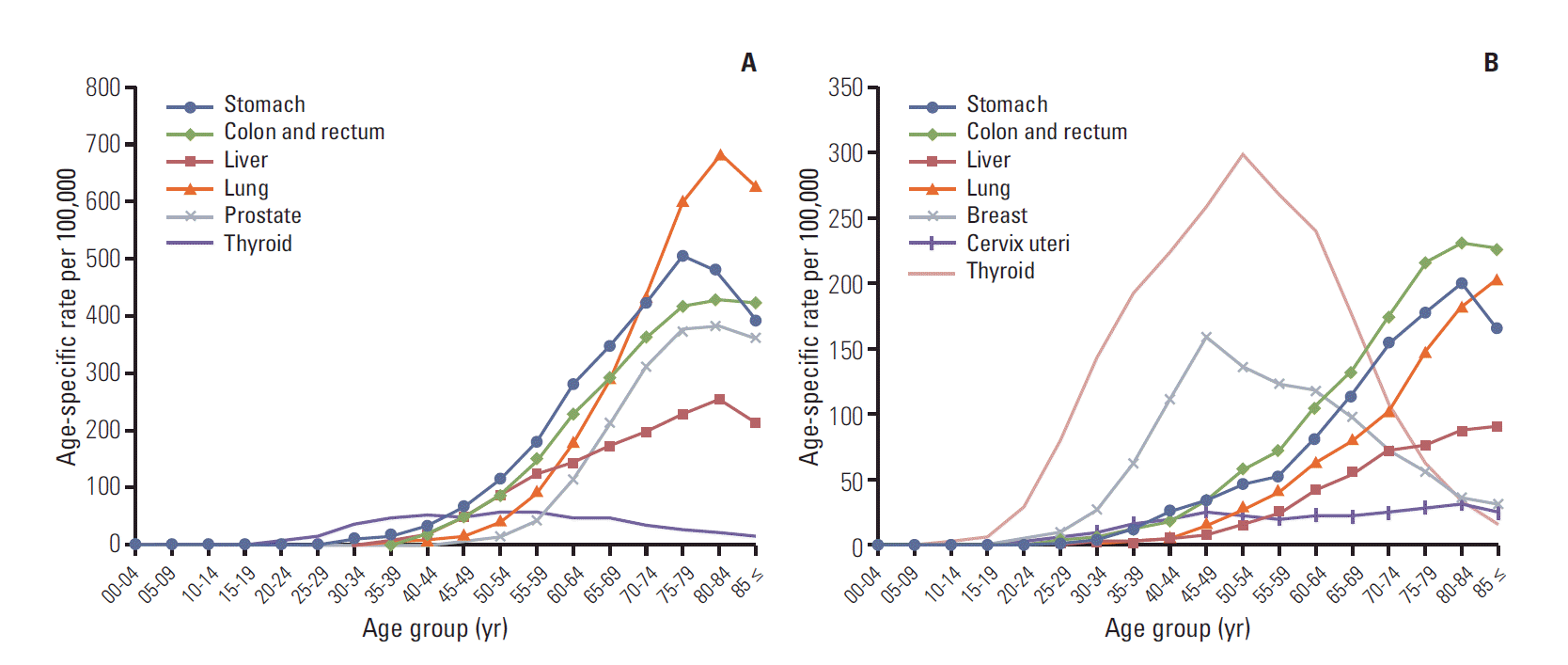
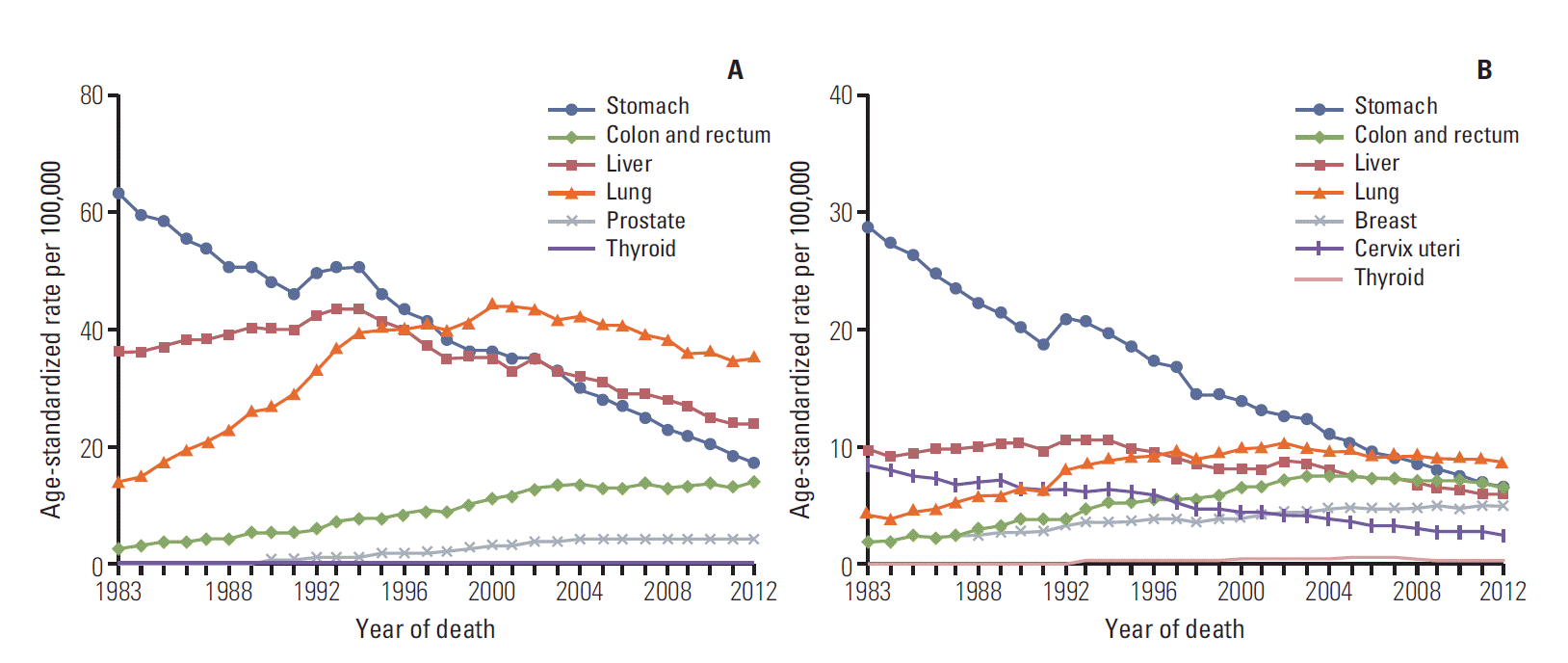
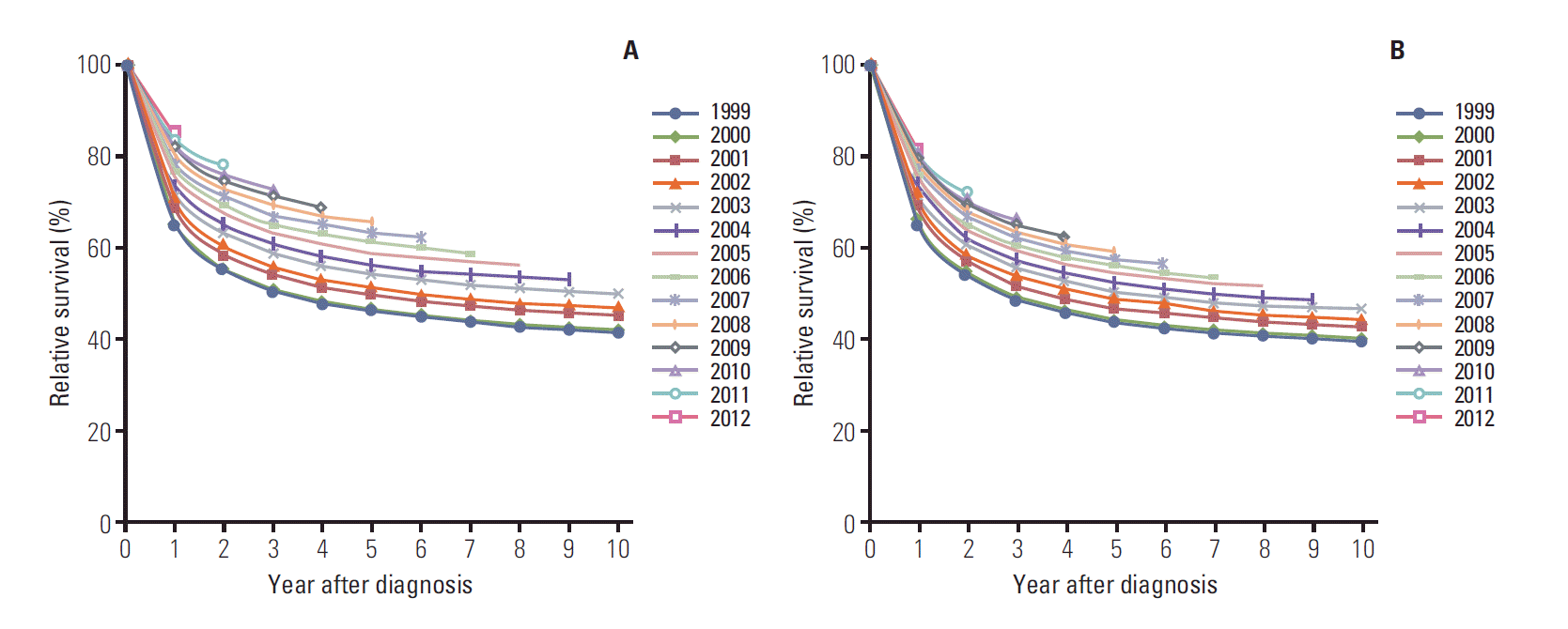
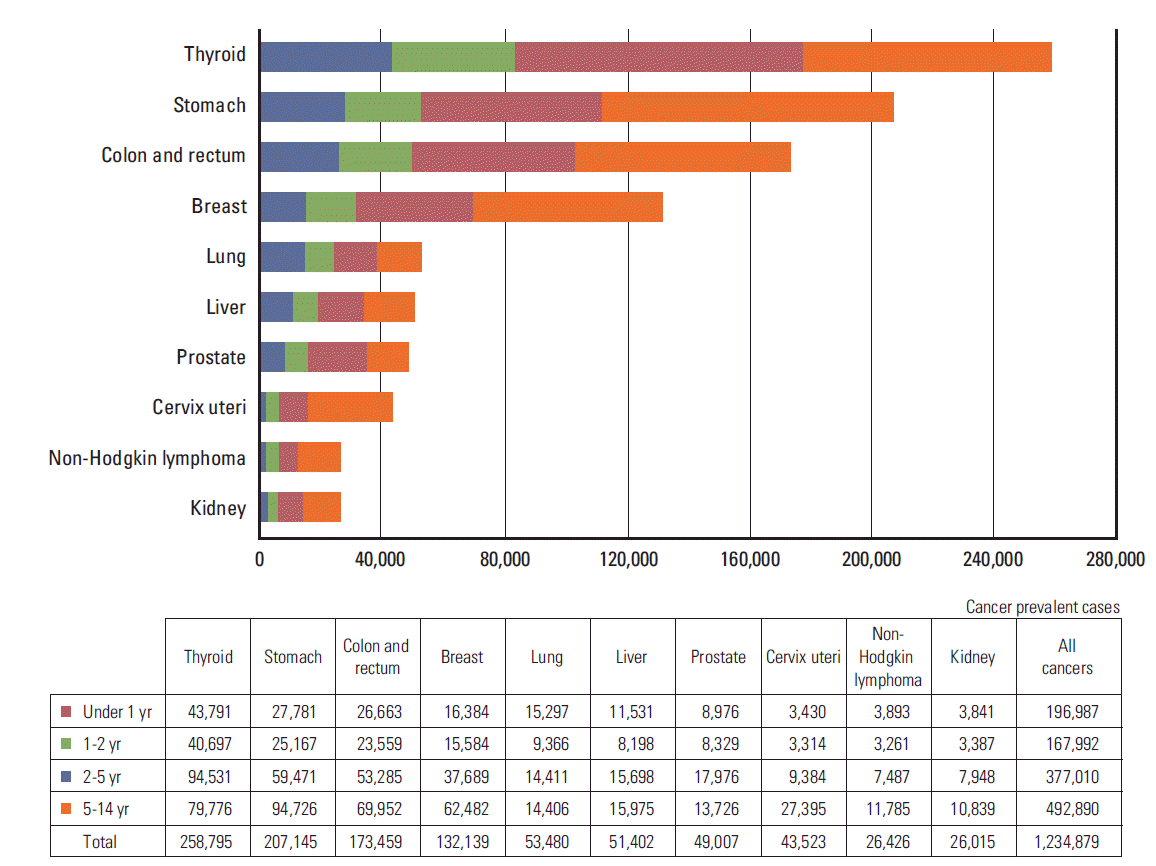
 XML Download
XML Download